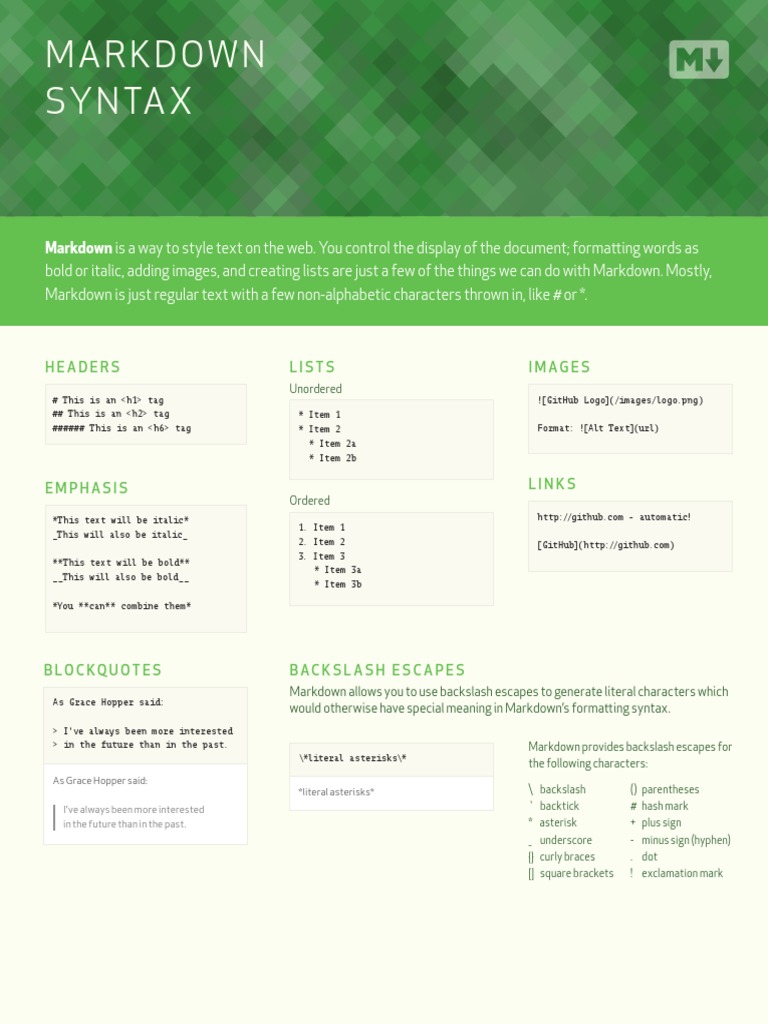This note demonstrates some of what Markdown is capable of doing.
Markdown Cheat Sheet. GitHub Gist: instantly share code, notes, and snippets.
Note: Feel free to play with this page. Unlike regular notes, this doesn’t automatically save itself.
In the case of GitHub, they will format the Readme file on the site. As long as you follow the standard, you can feel certain it will look good. Since GitHub has added just a few extensions, you should start by using a Markdown cheatsheet and go from there. Markdown cheat sheet used for github. Markdown allows you to use backslash escapes to generate literal characters which would otherwise have special meaning in Markdown’s forma ing syntax.
Basic formatting
- GitHub Flow Cheat Sheet. GitHub Flow Guide. Mastering Issues. Mastering Wikis. Getting started with GitHub Pages.
- This is intended as a quick reference and showcase for Markdown syntax.
Paragraphs can be written like so. A paragraph is the basic block of Markdown. A paragraph is what text will turn into when there is no reason it should become anything else.
Paragraphs must be separated by a blank line. Basic formatting of italics and bold is supported. This *can be nested like* so.
Lists

Ordered list
- Item 1
- A second item
- Number 3
- Ⅳ
Note: the fourth item uses the Unicode character for Roman numeral four.
Unordered list
- An item
- Another item
- Yet another item
- And there’s more…
Paragraph modifiers
Code block
You can also make inline code to add code into other things.
Quote
Github Markup Cheat Sheet
Here is a quote. What this is should be self explanatory. Quotes are automatically indented when they are used.
Headings
There are six levels of headings. They correspond with the six levels of HTML headings. You’ve probably noticed them already in the page. Each level down uses one more hash character.
Headings can also contain formatting
They can even contain inline code
Of course, demonstrating what headings look like messes up the structure of the page.
I don’t recommend using more than three or four levels of headings here, because, when you’re smallest heading isn’t too small, and you’re largest heading isn’t too big, and you want each size up to look noticeably larger and more important, there there are only so many sizes that you can use.
URLs
URLs can be made in a handful of ways:
- A named link to MarkItDown. The easiest way to do these is to select what you want to make a link and hit
Ctrl+L. - Another named link to MarkItDown
- Sometimes you just want a URL like http://www.markitdown.net/.
Horizontal rule
A horizontal rule is a line that goes across the middle of the page.
It’s sometimes handy for breaking things up.
Images
Markdown can also contain images. I’ll need to add something here sometime.
Finally
There’s actually a lot more to Markdown than this. See the official introduction and syntax for more information. However, be aware that this is not using the official implementation, and this might work subtly differently in some of the little things.
This note demonstrates some of what Markdown is capable of doing.
Note: Feel free to play with this page. Unlike regular notes, this doesn’t automatically save itself.
Basic formatting
Paragraphs can be written like so. A paragraph is the basic block of Markdown. A paragraph is what text will turn into when there is no reason it should become anything else.
Paragraphs must be separated by a blank line. Basic formatting of italics and bold is supported. This *can be nested like* so.
Lists
Ordered list
- Item 1
- A second item
- Number 3
- Ⅳ
Note: the fourth item uses the Unicode character for Roman numeral four.
Markdown Cheat Sheet Github Free
Unordered list
- An item
- Another item
- Yet another item
- And there’s more…
Paragraph modifiers
Code block
You can also make inline code to add code into other things.
Quote
Here is a quote. What this is should be self explanatory. Quotes are automatically indented when they are used.
Headings
There are six levels of headings. They correspond with the six levels of HTML headings. You’ve probably noticed them already in the page. Each level down uses one more hash character.
Headings can also contain formatting
They can even contain inline code
Of course, demonstrating what headings look like messes up the structure of the page.
I don’t recommend using more than three or four levels of headings here, because, when you’re smallest heading isn’t too small, and you’re largest heading isn’t too big, and you want each size up to look noticeably larger and more important, there there are only so many sizes that you can use.
URLs
URLs can be made in a handful of ways:
- A named link to MarkItDown. The easiest way to do these is to select what you want to make a link and hit
Ctrl+L. - Another named link to MarkItDown
- Sometimes you just want a URL like http://www.markitdown.net/.
Horizontal rule
A horizontal rule is a line that goes across the middle of the page.
It’s sometimes handy for breaking things up.
Images
Markdown can also contain images. I’ll need to add something here sometime.
Finally
There’s actually a lot more to Markdown than this. See the official introduction and syntax for more information. However, be aware that this is not using the official implementation, and this might work subtly differently in some of the little things.
